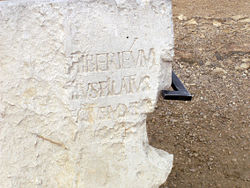
Pilate Stone
Encyclopedia
The Pilate Stone is the name given to a block (82 cm x 65 cm) of limestone
with a carved inscription attributed to Pontius Pilate
, a prefect of the Roman-controlled province of Judaea
from 26-36. The stone is significant because it is the only universally accepted archaeological find with an inscription mentioning the name "Pontius Pilatus" to date.
The Pilate Stone is currently located at the Israel Museum
in Jerusalem.
 On the partially damaged block is a dedication to the deified Augustus and Livia ("the Divine Augusti") of a Tiberieum (a building in honour of Tiberius Caesar Augustus
On the partially damaged block is a dedication to the deified Augustus and Livia ("the Divine Augusti") of a Tiberieum (a building in honour of Tiberius Caesar Augustus
). It has been deemed authentic because it was discovered in the coastal town of Caesarea, which was the capital of Iudaea Province
during the time Pontius Pilate
was Roman governor
.
The partial inscription reads (conjectural letters in brackets):
The translation from Latin to English for the inscription reads:
(built by decree of Herod the Great
c. 30 BC), called Caesarea Maritima in the present-day city of Caesarea-on-the-Sea (also called Maritima).
Limestone
Limestone is a sedimentary rock composed largely of the minerals calcite and aragonite, which are different crystal forms of calcium carbonate . Many limestones are composed from skeletal fragments of marine organisms such as coral or foraminifera....
with a carved inscription attributed to Pontius Pilate
Pontius Pilate
Pontius Pilatus , known in the English-speaking world as Pontius Pilate , was the fifth Prefect of the Roman province of Judaea, from AD 26–36. He is best known as the judge at Jesus' trial and the man who authorized the crucifixion of Jesus...
, a prefect of the Roman-controlled province of Judaea
Judaea (Roman province)
Judaea or Iudaea are terms used by historians to refer to the Roman province that extended over parts of the former regions of the Hasmonean and Herodian kingdoms of Israel...
from 26-36. The stone is significant because it is the only universally accepted archaeological find with an inscription mentioning the name "Pontius Pilatus" to date.
The Pilate Stone is currently located at the Israel Museum
Israel Museum
The Israel Museum, Jerusalem was founded in 1965 as Israel's national museum. It is situated on a hill in the Givat Ram neighborhood of Jerusalem, near the Bible Lands Museum, the Knesset, the Israeli Supreme Court, and the Hebrew University of Jerusalem....
in Jerusalem.
Inscription

Tiberius
Tiberius , was Roman Emperor from 14 AD to 37 AD. Tiberius was by birth a Claudian, son of Tiberius Claudius Nero and Livia Drusilla. His mother divorced Nero and married Augustus in 39 BC, making him a step-son of Octavian...
). It has been deemed authentic because it was discovered in the coastal town of Caesarea, which was the capital of Iudaea Province
Iudaea Province
Judaea or Iudaea are terms used by historians to refer to the Roman province that extended over parts of the former regions of the Hasmonean and Herodian kingdoms of Israel...
during the time Pontius Pilate
Pontius Pilate
Pontius Pilatus , known in the English-speaking world as Pontius Pilate , was the fifth Prefect of the Roman province of Judaea, from AD 26–36. He is best known as the judge at Jesus' trial and the man who authorized the crucifixion of Jesus...
was Roman governor
Roman governor
A Roman governor was an official either elected or appointed to be the chief administrator of Roman law throughout one or more of the many provinces constituting the Roman Empire...
.
The partial inscription reads (conjectural letters in brackets):
- [DIS AUGUSTI]S TIBERIÉUM
- [...PO]NTIUS PILATUS
- [...PRAEF]ECTUS IUDA[EA]E
- [...FECIT D]E[DICAVIT]
The translation from Latin to English for the inscription reads:
- To the Divine Augusti [this] Tiberieum
- ...Pontius Pilate
- ...prefect of Judea
- ...has dedicated [this]
Discovery
The limestone block was discovered in June 1961 by Italian archaeologists led by Dr. Antonio Frova while excavating an ancient theaterRoman theatre (structure)
The characteristics of Roman to those of the earlier Greek theatres due in large part to its influence on the Roman triumvir Gnaeus Pompeius Magnus. Much of the architectural influence on the Romans came from the Greeks, and theatre structural design was no different from other buildings...
(built by decree of Herod the Great
Herod the Great
Herod , also known as Herod the Great , was a Roman client king of Judea. His epithet of "the Great" is widely disputed as he is described as "a madman who murdered his own family and a great many rabbis." He is also known for his colossal building projects in Jerusalem and elsewhere, including his...
c. 30 BC), called Caesarea Maritima in the present-day city of Caesarea-on-the-Sea (also called Maritima).

